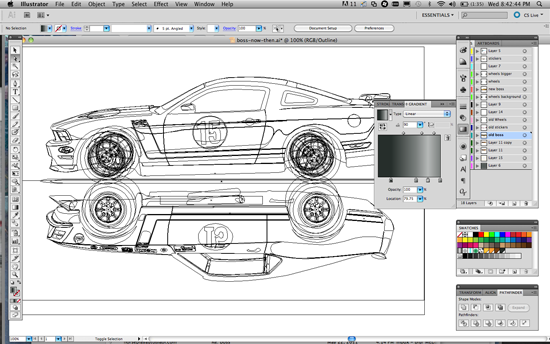I was even more pleased to learn of the first victory by Multimatic Motorsports in the modern Boss 302R in the same livery worn by Parnelli Jones during the first championship of the Boss. It got me to thinking...
I had seen other attempts to place the new and old Boss Mustang into a single portrait. There were other examples of ghost cars and reflected surfaces created for different circumstances. The one thing I never cared for in other artists attempts at reflecting old and new cars together was perspective. Usually the vanishing point for the reflected car was cheated - to the point of being unrealistic. Given the nature of reflections, we should see more 'underside' of the reflected car - not just a mirrored image of the surface car. So where in the world would I find reference material to work with?
 |
| As you can see from this photo of a diecast replica - even if the eye line is even with the hood of the car - we still see a significant amount of the undercarriage. |
 |
| Plenty of historical photos were available to reference body lines and sponsorship details (but - notice this car is wearing the wrong brand tires? Parnelli Jones owned Firestone stores) |
 |
| Additional views helped to understand awkward shapes like the front air damn. |
Last year I tagged along with my wife to a presentation given by artist James Gurney. (Dynotopia) During his presentation he pointed out the value of using actual models to study light and detail in illustration. Lucky for me I have a few things lying around the studio that can help.
Like most automotive enthusiasts - I happen to have a couple of die cast cars sprinkled throughout the garage and studio. I didn't have a '69 chassis available, and had to use a 1968 GT 500 instead. Ahh, the wonders of a digital SLR camera and a USB cable. I took advantage of some late afternoon light to establish a reference photo.
Finally! Justification for keeping all of these toys and models stashed away all of these years.
This reference really helped me decide how much of the underside of the car could be visible from this vantage point. Now it was just a matter of layout and lighting to determine what I would and wouldn't show.
That's about as sexy as it gets from the 'visual effects' department on this drawing. Since I draw 100% in Adobe Illustrator (vector based instead of pixel based) everything comes down to hand-drawn lines. Lots and lots of lines.
Fast forward about 30 hours into the project, and you can see the spaghetti that forms the structure of the drawing. This is contour drawing 101 (Ms. White - my high school art teacher would be proud.)
The final illustration is on 19"x13" trim cotton paper. We have a printer in the studio that produces museum archival prints. SOLD UN-MATTED - SHIPPED IN A TUBE. Every print is registered, and there are 78 prints remaining as of 09/07/12.
$49.95 1970 / 2011 Boss Mustang - Shipped
Paper Size: 13"x19"
Image Area / Matt Size: 11"x14"
Fine art Digital (Giclée - Definition) print
Archival Inks
Epson Velvet Fine Art Paper – Cotton Paper
Image Area / Matt Size: 11"x14"
Fine art Digital (Giclée - Definition) print
Archival Inks
Epson Velvet Fine Art Paper – Cotton Paper





Any interest in a commission project? I have a Boss '13 302LS and it would most interesting to see a stack of three (302 LS, 302S, and 302R). Purchased this print (1970/2011) but have ideas that I would be interested to see become reality
ReplyDelete